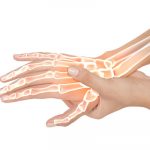Study finds ultrasound may aid in osteoporosis screening
In a study that could lead to the wide use of inexpensive ultrasound screenings for osteoporosis, researchers found data from ultrasonography of the calcaneus (heel bone) was equal to data gathered using dual-energy x-ray absorptiometry (DXA), which is considered the gold standard for assessing bone health.
The findings could lead to lower costs and increased screening for populations at-risk for bone diseases, which study authors say extends well beyond postmenopausal women.
“Prior research has demonstrated strong correlations between education level and socioeconomic status and bone quality,” says coauthor Andrea Nazar, DO, a family physician and professor of clinical science at West Virginia School of Osteopathic Medicine. “Because of its low-cost, mobility and safety, ultrasound is a promising tool for assessing more people, across multiple demographics.”
Researchers say DXA scans remain the best option for thorough, comprehensive information on a patient’s bone health. However, the equipment is expensive, immobile and exposes patients to ionizing radiation. Those limitations create barriers to screening larger populations.
“Using ultrasound to scan the heel won’t give us all the information we could gather with a full DXA scan,” says Carolyn Komar, Ph.D., associate professor of biomedical sciences at West Virginia School of Osteopathic Medicine and co-author on this study. “However, it gives us a clear enough snapshot to know whether we should be concerned for the patient.”
Healthy bones established early
Bone mineral density (BMD) is the quality measured to determine bone health. Nutrition, lifestyle, environment, physical activity and genetics all contribute to BMD. Peak BMD is established by our mid- to late-20s.
Because of its low-cost, mobility and safety, ultrasound is a promising tool for assessing more people, across multiple demographics.
BMD decreases naturally with age, which means people who do not establish sufficiently strong bones as young adults are at increased risk for diseases like osteoporosis later in life.
Dr. Nazar says the most effective lifestyle interventions for young adults are nutrition and exercise. A healthy, balanced diet contributes significantly to bone health. Also, weight-bearing exercises not only build muscle, which protects bone but also strengthen the bone itself.
“Most people think our bones are static structures once we reach adulthood. On the contrary, they are dynamic and shaped by how we live,” says Dr. Nazar. “There are pharmacologic options to treat osteoporosis and improve bone health, but the best approach is preventive lifestyle changes.”
Doctors of osteopathic medicine, or DOs, focus on prevention by gaining a deeper understanding of your lifestyle and environment, rather than just treating your symptoms.

